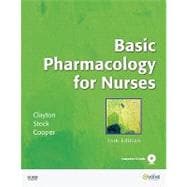
| Foundations of Pharmacology | |
| Definitions, Names, Standards, and Information Sources | |
| Principles of Drug Action and Drug Interactions | |
| Drug Action Across the Life Span | |
| The Nursing Process and Pharmacology | |
| Patient Education and Health Promotion | |
| Illustrated Atlas of Medication Administration and Math Review | |
| A Review of Arithmetic | |
| Principles of Medication Administration and Medication Safety | |
| Percutaneous Administration | |
| Enteral Administration | |
| Parenteral Administration: Safe Preparation of Parenteral Medications | |
| Parenteral Administration: Intradermal, Subcutaneous, and Intramuscular Routes | |
| Parenteral Administration: Intravenous Route | |
| Drugs Affecting the Autonomic and Central Nervous Systems | |
| Drugs Affecting the Autonomic Nervous System | |
| Sedative-Hypnotics | |
| Drugs Used for Parkinson's Disease | |
| Drugs Used for Anxiety Disorders | |
| Drugs Used for Mood Disorders | |
| Drugs Used for Psychoses | |
| Drugs Used for Seizure Disorders | |
| Drugs Used for Pain Management | |
| Drugs Affecting the Cardiovascular System | |
| Introduction to Cardiovascular Disease and Metabolic Syndrome | |
| Drugs Used to Treat Dyslipidemias | |
| Drugs Used to Treat Hypertension | |
| Drugs Used to Treat Dysrhythmias | |
| Drugs Used to Treat Angina Pectoris | |
| Drugs Used to Treat Peripheral Vascular Disease | |
| Drugs Used to Treat Thromboembolic Disorders | |
| Drugs Used to Treat Heart Failure | |
| Drugs Used for Diuresis | |
| Drugs Used to Treat Disorders of the Respiratory System | |
| Drugs Used to Treat Upper Respiratory Disease | |
| Drugs Used to Treat Lower Respiratory Disease | |
| Drugs Affecting the Digestive System | |
| Drugs Used to Treat Oral Disorders | |
| Drugs Used to Treat Gastroesophageal Reflux and Peptic Ulcer Diseases | |
| Drugs Used to Treat Nausea and Vomiting | |
| Drugs Used to Treat Constipation and Diarrhea | |
| Drugs Affecting the Endocrine System | |
| Drugs Used to Treat Diabetes Mellitus | |
| Drugs Used to Treat Thyroid Disease | |
| Corticosteroids | |
| Gonadal Hormones | |
| Drugs Affecting the Reproductive System | |
| Drugs Used in Obstetrics | |
| Drugs Used in Men's and Women's Health | |
| Drugs Affecting Other Body Systems | |
| Drugs Used to Treat Disorders of the Urinary System | |
| Drugs Used to Treat Glaucoma and Other Eye Disorders | |
| Drugs Used for Cancer Treatment | |
| Drugs Used to Treat the Muscular System | |
| Antimicrobial Agents | |
| Nutrition | |
| Herbal and Dietary Supplement Therapy | |
| Substance Abuse | |
| Miscellaneous Agents | |
| Bibliography | |
| Illustration Credits | |
| Index | |
| Answers to Medication Safety Review | |
| Appendices [on Evolve at http://evolve.elsevier.com/Clayton/] | |
| Common Prescription Abbreviations | |
| Medical Abbreviations | |
| Nomogram for Calculating the Body Surface Area of Adults and Children | |
| Commonly Used Laboratory Test and Drug Values | |
| Recommended Childhood Immunization Schedule -- United States, 2008 UPDATED! | |
| MedWatch Drug Reporting Form | |
| Dyskinesia Identification System: Condensed User Scale (DISCUS) | |
| A Simple Method to Determine Tardive Dyskinesia Symptoms: AIMS Examination Procedure | |
| Templates for Developing a Written Record for Patients to Monitor Their Own Therapy | |
| Glossary [on Evolve at http://evolve.elsevier.com/Clayton/] | |
| Table of Contents provided by Publisher. All Rights Reserved. |
The New copy of this book will include any supplemental materials advertised. Please check the title of the book to determine if it should include any access cards, study guides, lab manuals, CDs, etc.
The Used, Rental and eBook copies of this book are not guaranteed to include any supplemental materials. Typically, only the book itself is included. This is true even if the title states it includes any access cards, study guides, lab manuals, CDs, etc.